This is the traditional recipe for Ossobuco alla Milanese, a veal or beef shank slow-cooked to tender perfection with wine and bone marrow stock. What makes this dish unique is the valuable bone marrow inside the bone, which is served whole for maximum flavor. This is the traditional recipe with the essential final touch of lemon zest, just like the one I had when living in Milan. The authentic Milanese recipe uses no tomato sauce.
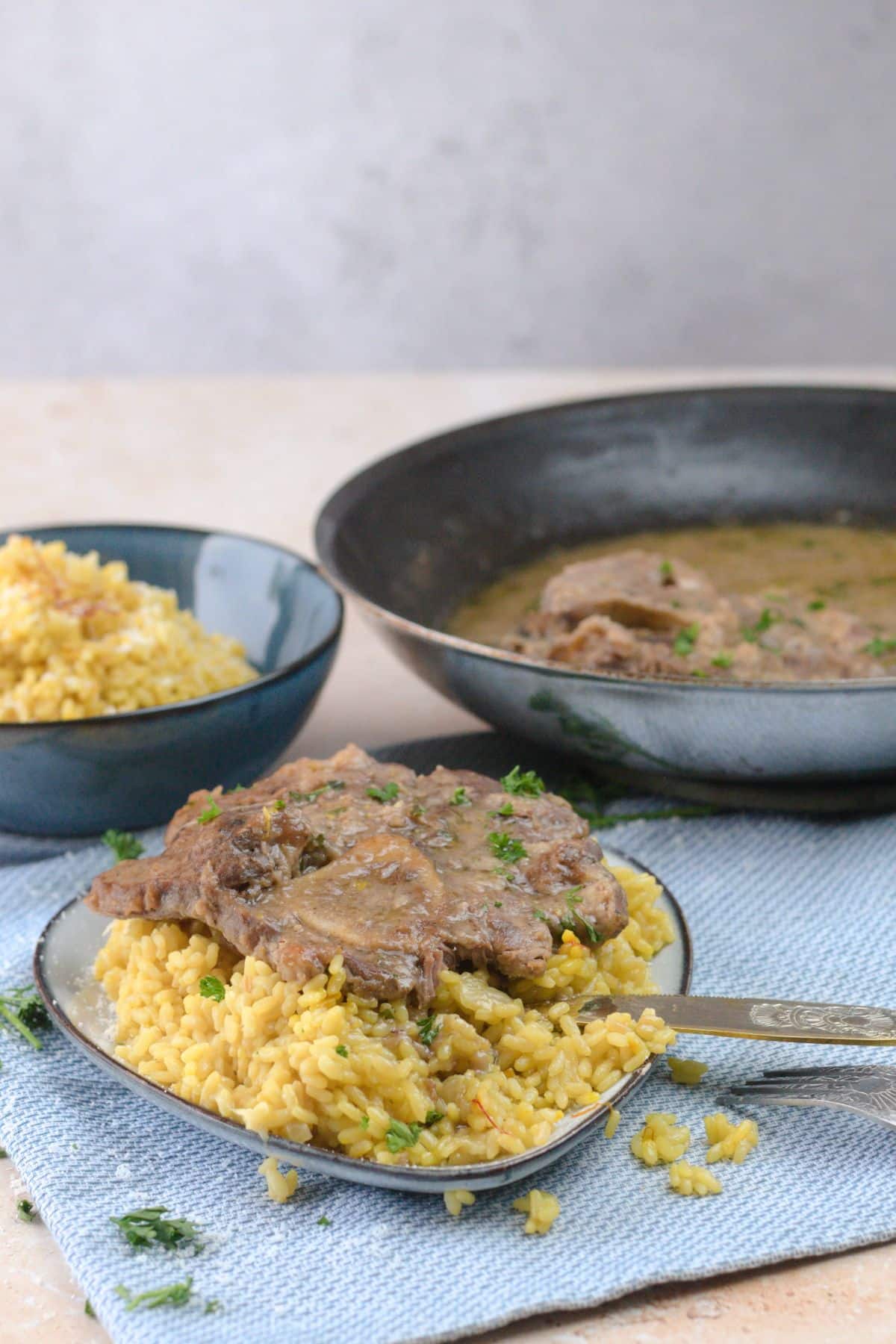
Authentic Ossobuco alla Milanese: The Truth vs. Online Myths
Pellegrino Artusi, in his seminal cookbook La Scienza in cucina, acknowledged the Milanese mastery of this classic dish, advising cooks to leave this particular recipe to them.
In fact, there are different recipes on the internet claiming to be the recipe for ossobuco alla milanese, but they are not.
As reported in the classic Italian cookbook Il Talismano della felicità and confirmed by the recipes in my mother's Cordon Bleu cooking course books from the '70s, the recipe of ossobuco with tomato sauce is called Ossobuco alla cacciatora.
My mother always made the Milanese recipe, and this is the same authentic flavor I enjoyed when living in Milan.
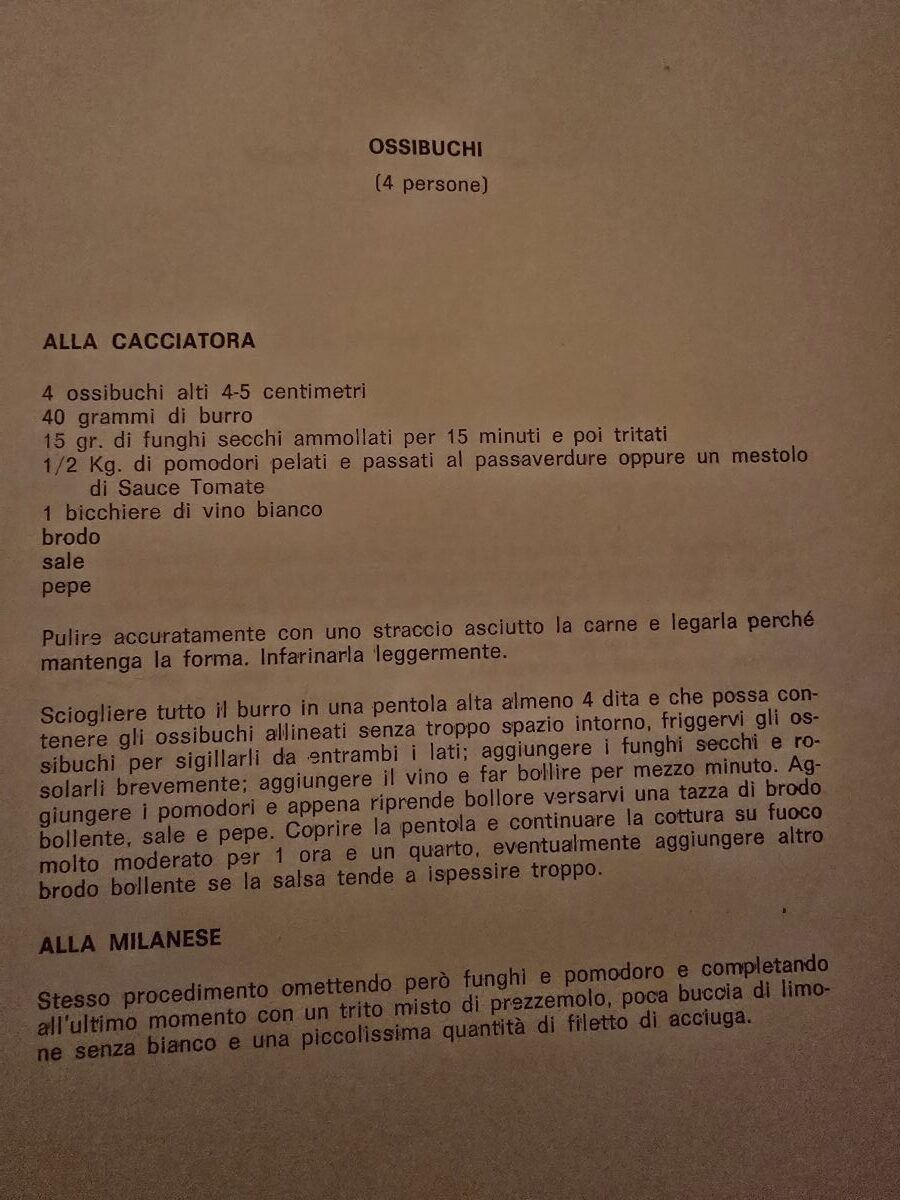
The name Ossobuco (in Italian is one word) literally translates to "bone with a hole," referring to the cut of meat itself.
The authentic version is slow-cooked to yield a deep, velvety sauce while preserving the bone marrow whole to be enjoyed with the meat.
The defining final touch is the Gremolata-a bright, fresh blend of lemon zest, parsley, garlic, and anchovies.
This garnish is essential and provides a sharp contrast to the rich meat.
This authentic version steers clear of the tomato-heavy variations. Instead, the focus is on developing a sophisticated depth of flavor through long, slow cooking in stock and wine.
This dish is traditionally served alongside its perfect partner, Risotto alla Milanese (risotto with saffron), for a complete and unforgettable meal.
For more recipes from the Lombardy region, you can check: cotoletta alla Milanese, Torrone, Malfatti, fried polenta.

Ingredients
The quality of ingredients is at the center of any Italian recipe, and this Milanese classic relies on rich, fresh components.
- Veal or Beef Shanks (Ossobuco): These large, cross-cut shanks are the star of the dish, prized for the bone and essential marrow. The connective tissue helps the sauce thicken as the meat is slow-cooked to fork-tenderness.
- Plain Flour (Type 00): A light coating for the shanks is essential to create a thin crust when searing, which also helps build a rich base for the sauce. Type 00 flour is equivalent to pastry flour.
- Butter: This fat is used for searing the meat and is often favored in Northern Italian cooking for its richness.
- Dry White Wine (Secco): Used to deglaze the pan. Its acidity cuts through the richness and adds a layer of depth to the slow-cooked sauce.
- Bone Broth or Stock: The braising liquid for the slow-cooking process. Using a quality stock adds crucial depth and savory notes, which are essential for a deeply comforting meal. When winter approaches, I make large batches of homemade chicken and brown stock to fill my freezer
- Gremolata Components: This is the traditional, authentic garnish that provides the necessary sharp contrast to the rich meat. It is composed of:
- Lemon Zest: The bright, aromatic outer peel of an unwaxed lemon provides a vital lift and acidity to cut through the richness of the veal and bone marrow.
- Fresh Parsley: Flat-leaf parsley is used for its fresh, slightly peppery flavor and vibrant green color.
- Garlic: Essential for a pungent, sharp flavor in the Gremolata.
- Anchovies (Optional): Anchovies link to the Ancient Roman food history; the Romans used a salty fish sauce called Garum, their equivalent to modern ketchup. Anchovies provide a natural umami flavor. I prefer anchovies stored in salt, as I always doubt the quality of the oil used to preserve commercial jars. They need to be rinsed and deboned before use. A small, finely minced fillet adds a deep umami and salty dimension to the Gremolata.
Find the measurements in the recipe card.
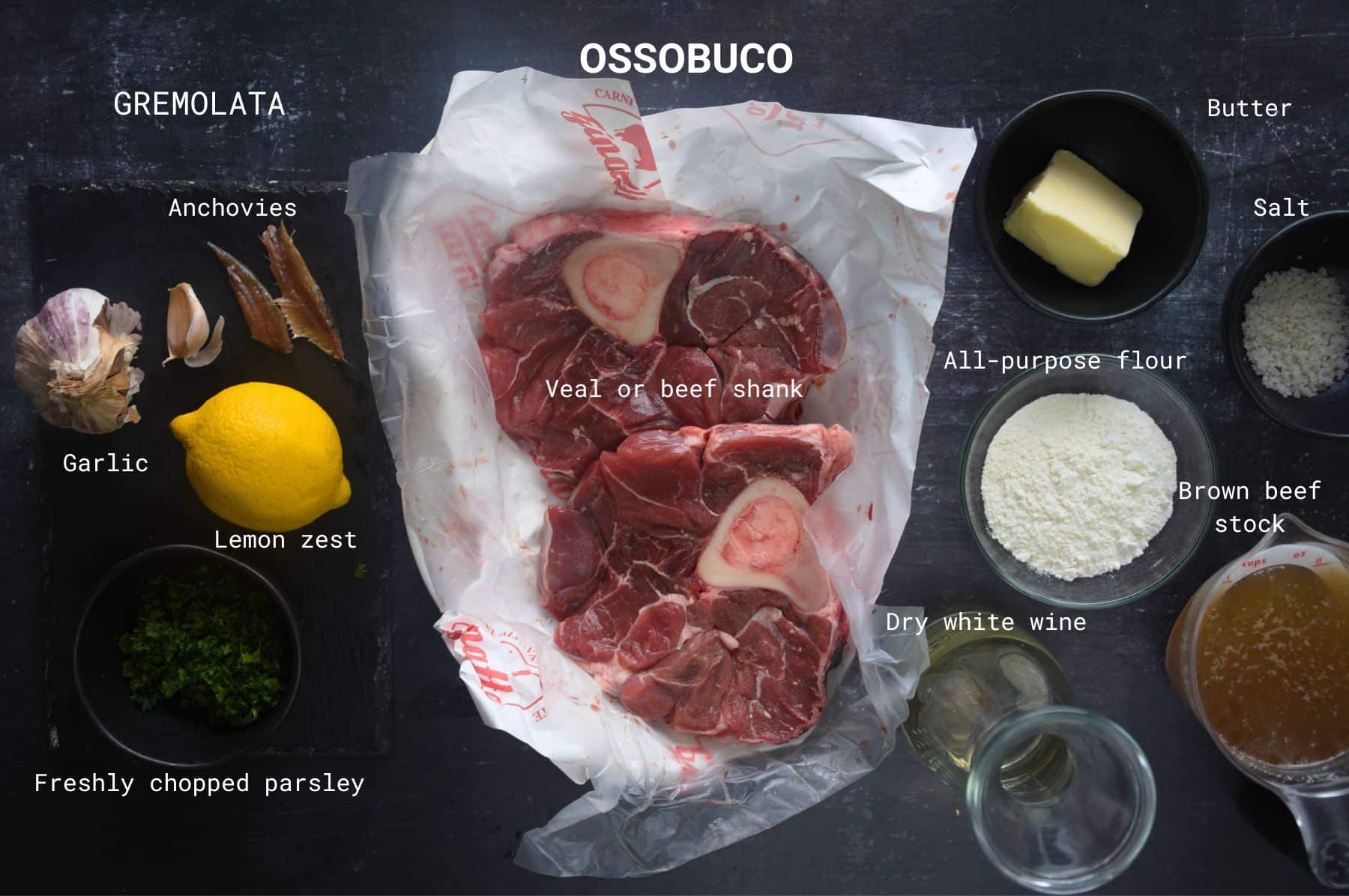
Italian beef cuts translated into English
Ossobuco is made from the veal or beef shank, a cut highly valued in traditional Italian cooking.
When buying your meat, it helps to understand the Italian cuts and how they translate into English:
- 8 & 9 Shank in Italian Campanello or Muscolo, in French Jarret, Gîte
- 10 & 11 Round in Italian Girello or Controgirello, in French Semelle, Jumeau
- 12 Chuck in Italian Giovarro or Collo, in French Collier

Before cooking, ask your butcher to make several small, shallow cuts around the meat, slicing into the white connective tissues.
This simple step is vital: it prevents the meat from tightening, curling up, and separating from the bone during the long braising process, ensuring your shanks remain flat for even cooking.

Step by step instructions
- Use a large pot or Dutch oven, wide enough to fit the shanks.
- Pat the veal shanks dry and inspect the meat; if your butcher hasn't already done so, make shallow cuts into the connective tissue around the edges to prevent the meat from curling as it cooks.
- Lightly dredge the shanks in the plain flour, shaking off the excess.
- In the pot, melt the butter over medium-high heat.
- Sear the shanks until deeply golden-brown on both sides-this browning is essential for developing the deep flavor.
- Pour in the dry white wine, increase the heat, and let it bubble. Scrape up any browned bits from the bottom of the pan to incorporate them into the liquid. Let the wine reduce by half to concentrate the flavor and remove the alcohol.
- Pour in enough bone broth or stock to reach about two-thirds of the way up the meat. Bring the liquid to a gentle simmer, then cover the pot with a lid.
- Slow-cook the ossobuco for 1 hour, or until the meat is fork-tender. The sauce will thicken naturally from the melted connective tissue.
- If the sauce seems too thin, remove the lid for the last 15 minutes of cooking to allow some liquid to evaporate and reduce. The goal is a velvety, deep sauce.
- In the last 5 minutes of cooking, add the lemon zest, garlic, anchovy filet (it will melt in the pan), and chopped parsley directly to the pot.
- Let the juice and the meat absorb the flavor. Remove the pot from the heat.
- Carefully lift the ossobuco shanks and place them on individual serving plates. Spoon the pan sauce over the meat. Serve immediately.
Serving Suggestions
This deeply flavorful and rich classic is traditionally served with its Milanese counterpart, Risotto alla Milanese (risotto with saffron), for a complete and luxurious Italian meal.
The rice's creamy texture provides the perfect base to absorb the deep, velvety pan sauce.
To stay authentic to the region, avoid serving cheese on top of the Ossobuco, as its rich, delicate flavor profile should not be overpowered.

If you prefer a lighter side, a simple potato purée or creamy polenta also pairs well.
For a truly authentic experience, don't forget to savor the delicious bone marrow-the ossobuco's crowning component-often scooped out and spread onto crusty bread.
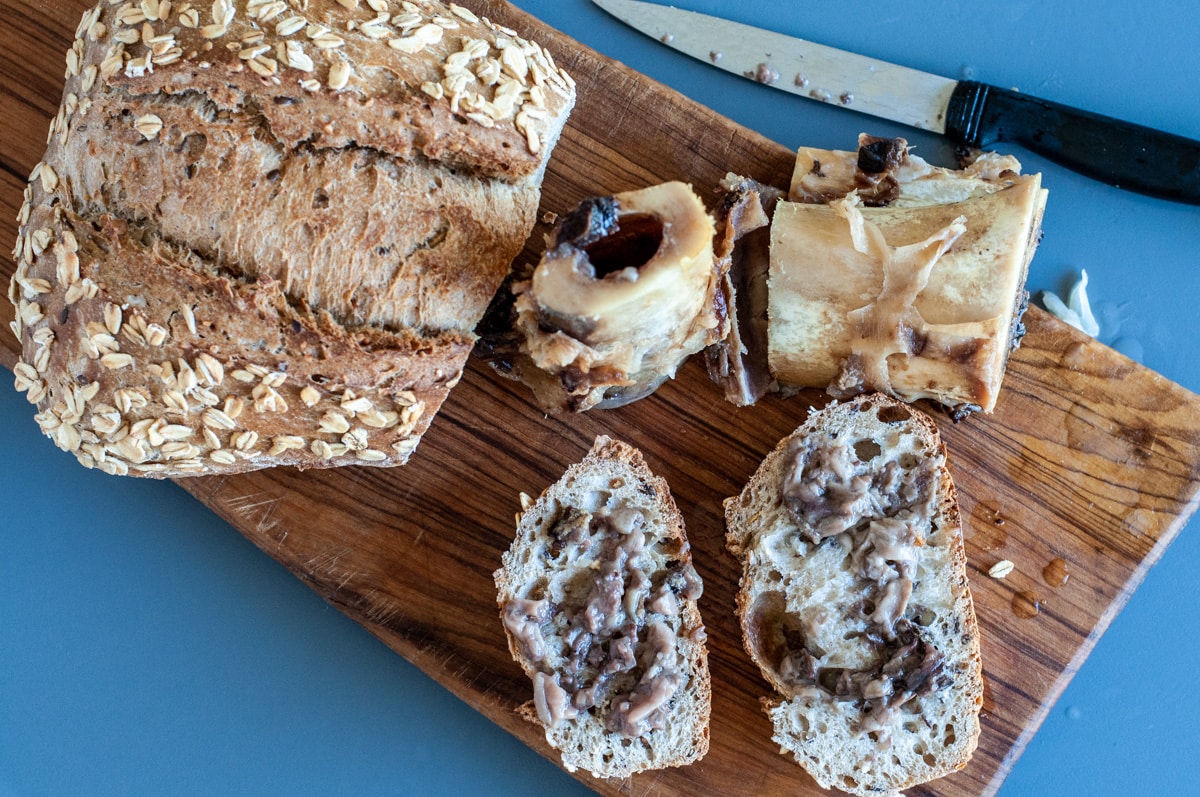
More Milanese recipes
If you are making this Ossobuco alla Milanese, leave your comment below I would like to hear from you. You can find more delicious ideas if you FOLLOW ME on Facebook, YouTube, Instagram or sign up to my newsletter.

Traditional Beef Shank Ossobuco Alla Milanese (No Tomato)
Verified Culinary AuthorityEquipment
Ingredients
- 2 Veal or beef shank about 500 g - 1lb
- ½ cup all-purpose flour
- 2 tablespoon butter
- ½ cup dry white wine
- ½ cup brown beef stock made with bone marrow
- ½ lemon zest
- ½ filet anchovies stored in salt
- 1 peeled garlic cloves
- 1 teaspoon salt & pepper
- 2 tablespoon freshly chopped parsley
Instructions
- Use a large pot or Dutch oven, wide enough to fit the shanks.
- Pat the veal shanks dry and inspect the meat; if your butcher hasn't already done so, make shallow cuts into the connective tissue around the edges to prevent the meat from curling as it cooks.
- Lightly dredge the shanks in the plain flour, shaking off the excess.
- In the pot, melt the butter over medium-high heat.
- Sear the shanks until deeply golden-brown on both sides-this browning is essential for developing the deep flavor.
- Pour in the dry white wine, increase the heat, and let it bubble. Scrape up any browned bits from the bottom of the pan to incorporate them into the liquid. Let the wine reduce by half to concentrate the flavor and remove the alcohol.
- Pour in enough bone broth or stock to reach about two-thirds of the way up the meat. Bring the liquid to a gentle simmer, then cover the pot with a lid.
- Slow-cook the ossobuco for 1 hour, or until the meat is fork-tender. The sauce will thicken naturally from the melted connective tissue.
- If the sauce seems too thin, remove the lid for the last 15 minutes of cooking to allow some liquid to evaporate and reduce. The goal is a velvety, deep sauce.
- In the last 5 minutes of cooking, add the lemon zest, garlic, anchovy filet (it will melt in the pan), and chopped parsley directly to the pot.
- Let the juice and the meat absorb the flavor. Remove the pot from the heat.
- Carefully lift the ossobuco shanks and place them on individual serving plates. Spoon the pan sauce over the meat. Serve immediately
Video
Nutrition


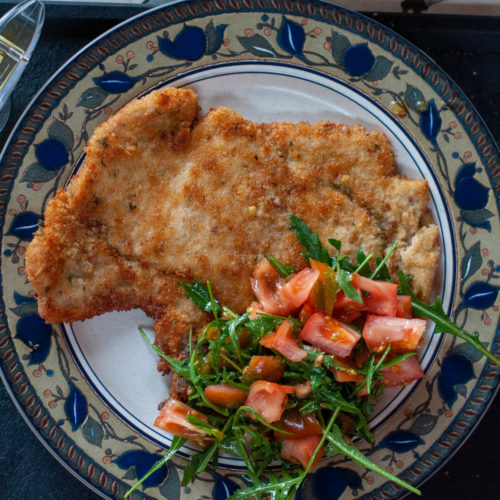

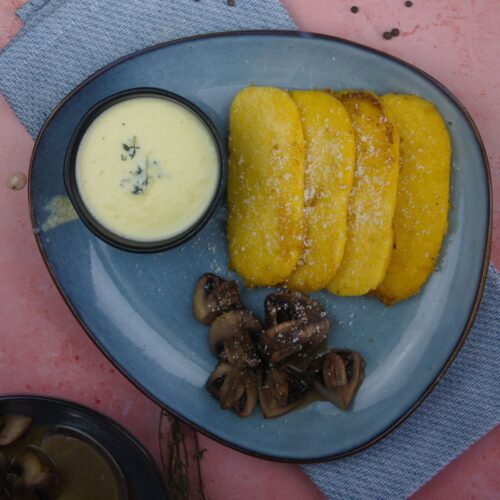




Leave a Reply